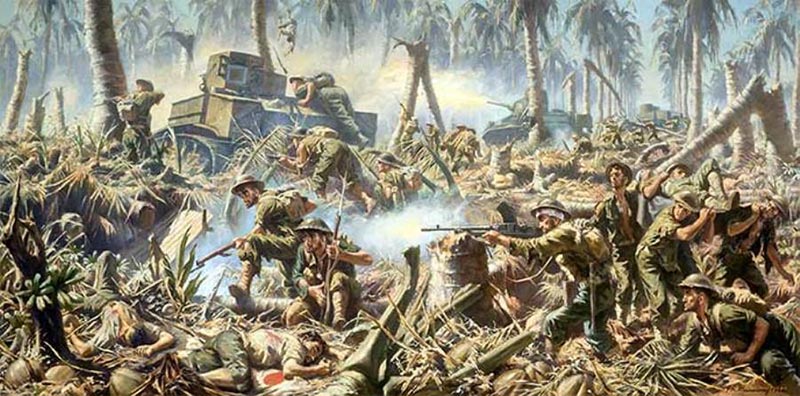

NEWS THAT MATTERS
Commemorating Battle for Australia
On the first Wednesday in September, Australians come together for Battle of Australia Day, to honour the service and sacrifice of all those who served in defence of Australia in 1942 and helped contribute to the defeat of Japan during the Second World War. The following day at the ANZAC Memorial in Hyde Park, Australian soldiers killed in the country’s deadliest air disaster, on 7 September 1943, were also commemorated.

Photo courtesy Battle for Australia Association.
13 September 2023
MINISTER for Veterans David Harris laid a sprig of wattle, alongside members of the veteran community at the Cenotaph in Martin Place Sydney on the 81st anniversary of the Battle for Australia.
Prime Minister John Curtin used the term ‘Battle for Australia’ after the fall of Singapore on 15 February 1942. Soon after, Australia suffered direct Japanese attacks, including the bombing of Darwin, with many merchant and Navy ships sunk defending our shores.
Over 39,000 Australians died during the Second World War, most of them in the campaigns in Asia and the Pacific. Many more were wounded in action and approximately 22,000 Australians became prisoners of war.
During the Great War, the golden wattle was used as a symbol of unity on the home front, and this continued through the Second World War. The resilience of wattle, to withstand our nation’s harsh weather of droughts, winds and bushfires, represents the spirit of the Australian people and sprigs of wattle are laid as a tribute for the Battle of Australia commemoration.
Minister for Veterans, David Harris said, “The Second World War was the first time that our nation and our land was under attack.
“We come together to remember the efforts of our veterans who protected our nation. Who fought to defend our border, our mainland and throughout the Pacific to keep us safe.
“Their efforts, eighty-one years ago, contributed to the first defeat of Japanese forces on land in New Guinea, with the Battle of Milne Bay.
“Whilst the early years of the war focused on Europe, it was during 1942 that Australian forces drew on the spirit of the Anzacs to hold off and eventually overcome the Japanese along the Kokoda Track and other significant battles in New Guinea and throughout the Pacific.
“On the home front, we defended the attacks in Darwin and later in Sydney Harbour. All these efforts helped to win the war against Japan.
“It is these efforts and sacrifices that we remember today. Lest we forget.”
Immediate past President of the Battle for Australia Association in NSW, Colonel Davis Ross CSC (Ret’d) said, “Today we honour the service and sacrifice of our solders, sailors and air crew as well as all the efforts on the home front. We remember their contributions against the aggression of the Japanese forces, that led to a victory in the Battle for Australia.”
The following day Australian soldiers killed in the country’s deadliest air disaster, on 7 September 1943, were also commemorated.
No Australian battalion suffered a greater loss than the 2/33rd Battalion did 80 years ago when, in a matter of seconds, it lost 60 men, killed or mortally injured, and another 90 injured as a result of the US Liberator B-24 Bomber crash in Port Moresby.
In pre-dawn darkness, the Liberator was taking off for a reconnaissance mission with 4 x 500lb bombs fitted as opposed to the carrying capacity of 12 bombs. For reasons unknown, the Liberator failed to gain sufficient height and hurtled towards the men on the ground in the convoy of trucks lining the airstrip. The bomber came crashing down, spilling forward a wave of burning aviation fuel engulfing the five lorries and causing catastrophic damage.
Survivors were sworn to secrecy and details of the crash were kept from the families of those who died to keep up morale during the Second World War.
Minister for Veterans David Harris attended the special commemoration service with members of the 2/33rd Australian Infantry Battalion AIF Association and the veteran community to lay a wreath in honour of all those who served, their families and loved ones.
Minister for Veterans, David Harris said, “We remember the members of the 2/33rd Battalion who sadly lost their lives 80 years ago in one of the darkest days of the Second World War.
“In the blink of an eye our nation lost 62 men, 60 soldiers of the 2/33rd Battalion as well as two Australian truck drivers.
“We pay tribute to the ultimate sacrifice they gave for their country, to keep us safe. We also remember the 11 airmen of the United States who also perished during the crash. Lest we forget.”
Mrs Yvonne Unitt, President of the 2/33rd Australian Infantry Battalion AIF Association also laid a wreath to honour the Association’s fallen comrades.
“The commemoration of the 80th Anniversary of the Liberator crash, Australia’s deadliest air disaster, marks another milestone in our Association’s important work of honouring and remembering not only the courage, service and sacrifice of our 2/33rd Battalion soldiers.
“Formed in August 1945, four days after the Americans dropped the atomic bomb on Hiroshima our Association’s work has become even more important because it is one of the few Second World War associations still in existence and has a strong support from the relatives of the 3,065 men who wore the battalion’s famous red and brown colour patches into battles in the Middle East, Papua New Guinea and Borneo.”


SUBSCRIBE FOR FREE to the Grapevine News Online and to the monthly e-book edition of the Grapevine Community News. You will receive an email notification every time a news story goes live, keeping you up to date with what is happening in your community.
Our online news platform and monthly newspaper is about real local news and events. We will not spam you or share your details with third parties.








%20advert.jpg?crc=3763325189)









